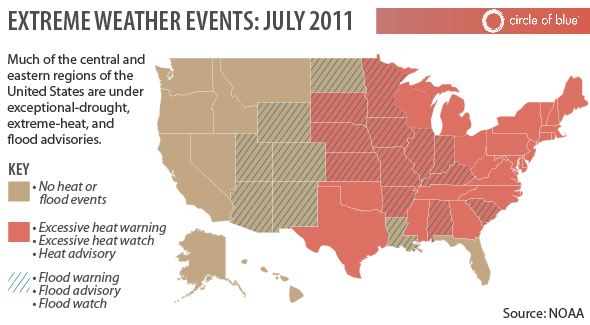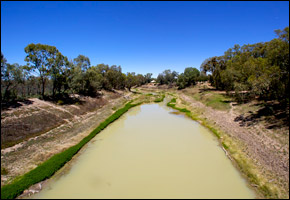Weather Extremes: Floods, Droughts, Tornadoes, and Extreme Heat Plague Much of U.S.
Extreme weather events in 2011 have been numerous and diverse, prompting some analysts to link the natural disasters to climate change. Most recently, many states are under exceptional-drought and extreme-heat advisories.
The central and eastern regions of the United States are baking in brutal heat, continuing the series of extreme weather events that have raged across the country since the beginning of the year.
At least 14 states recorded 100 degrees Fahrenheit on Monday, and more than 40 topped 90 degrees, prompting authorities to close many government buildings and send warnings to residents to keep as cool as possible. As the heat wave intensified at the beginning of the week, the National Weather Service put 18 states under a heat warning, watch, or advisory, Reuters reported.
The high temperatures and lack of rain in the U.S. plains has tightened the grip of a continued Texas drought, which has been ongoing since last October. The drought is the worst in the state in a century and the third-worst in Texas history.
Meanwhile, “exceptional drought,” the most severe category measured by climatologists, has consumed more than 70 percent of Texas and more than 40 percent of Oklahoma, with the classification now stretching into Kansas, a top winter wheat producer, according to the U.S. Drought Monitor. Drought conditions have also spread from the Southwest to the southern Atlantic states, including thousands of wildfires — from Arizona, which is fighting the largest wildfire in its history, to Florida, where fires have burned thousands of acres so far.
A recent opinion piece in The New York Times has warned that certain regions of the United States, like the Southwest, are facing a “permanent drying out.”
Cause and Effects
Climatologists blame the droughts on the La Niña weather phenomenon, or the abnormal cooling of Pacific waters, and the U.S. Climate Prediction Center forecasted last week that the weather pattern might resume this fall, Reuters reported. The high concentration of weather extremes in 2011 has prompted some analysts to link the series of floods, heat waves, droughts, and storms to climate change.
The severe dry spell has withered grazing land for cattle, ruined thousands of acres of cropland, and added upward pressure on global food prices, according to the U.S. Department of Agriculture. For instance, the hot weather is posing a serious threat to corn, farmers’ top cash crop, as it enters the key growth stage.
The drought has also threatened energy production in Texas, as Bloomberg News reported the intensifying competition for water between agriculture and energy industries in June. As government officials have been rationing the water supplies for shale gas exploration and drilling, power companies have been going farther afield to buy water from farmers, irrigation districts, and municipalities. The water is needed for hydraulic fracturing, or “fracking,” the process of injecting water, chemicals, and sand at high pressure into underground rock formations to free up the oil and natural gas trapped inside.
And while much of the South has been basking in heat, earlier this summer, record snowfall and heavy rains from Iowa to Montana inundated much of the northern Great Plains. In June, historic flooding forced the evacuation of scores of residents in Minot, North Dakota, and swamped millions of acres of farmland in the top wheat-producing state.
The scores of floods and droughts this year have followed the unprecedented series of tornados that devastated towns in Missouri, Alabama, Kansas, Arkansas, Minnesota, and Massachusetts — killing hundreds of people and leaving many more injured or missing. In April, a violent tornado swept across the South, unleashing flash floods that raised the water levels at the confluence of the Mississippi and Ohio rivers.
Source: Alternet, Bloomberg News, The New York Times, Reuters, UPI, U.S. Department of Agriculture
, a Bulgaria native, is a Chicago-based reporter for Circle of Blue. She co-writes The Stream, a daily digest of international water news trends.
Interests: Europe, China, Environmental Policy, International Security.








When you have a driver’s license, you know how to drive a car, but when the car will not start, you bring it to someone who knows how cars are supposed to work, so he can do his analysis of what is wrong and fix it. Before fixing anything, it therefore is always advisable to first understand the basics, but when one reads about global warming and weather, we deal with the atmosphere and what is happening to the molecules that make up the atmosphere and I yet have to read what happens with these molecules. After some reading I know that they move with horrendous speed (oxygen at 1,600 miles per hour), pending their molecular weights and bump into each other. Their speed also depends on the temperature, as a result of electromagnetic waves adsorbed form the sun or the Earth. Common sense tells us that there must be relationship between the dispersion of molecules and their speeds, and, if that is the case, it will explain why dispersion (of energy) is slower when you have more larger (slower moving) molecules as the result of the burning of fossil fuels. If dispersion would be instantaneous, there would not be any weather conditions.
Maybe if people would learn more about the basic principles of how molecules making up the air behave, it may be easier to convince them (even Senator Inhofe) that we are dealing with a serous issue and that any more increase of larger molecules in our atmosphere, will delay dispersion and thus cause more weather-related problems.